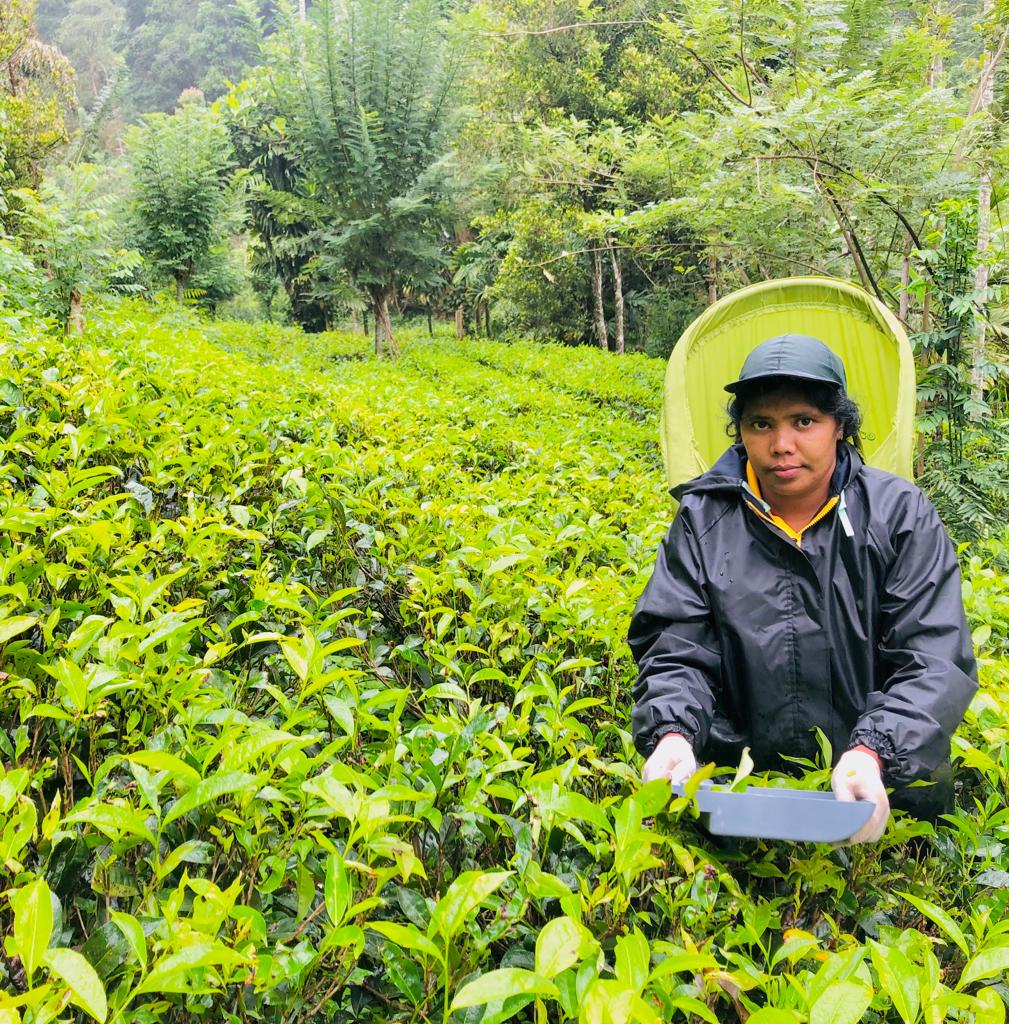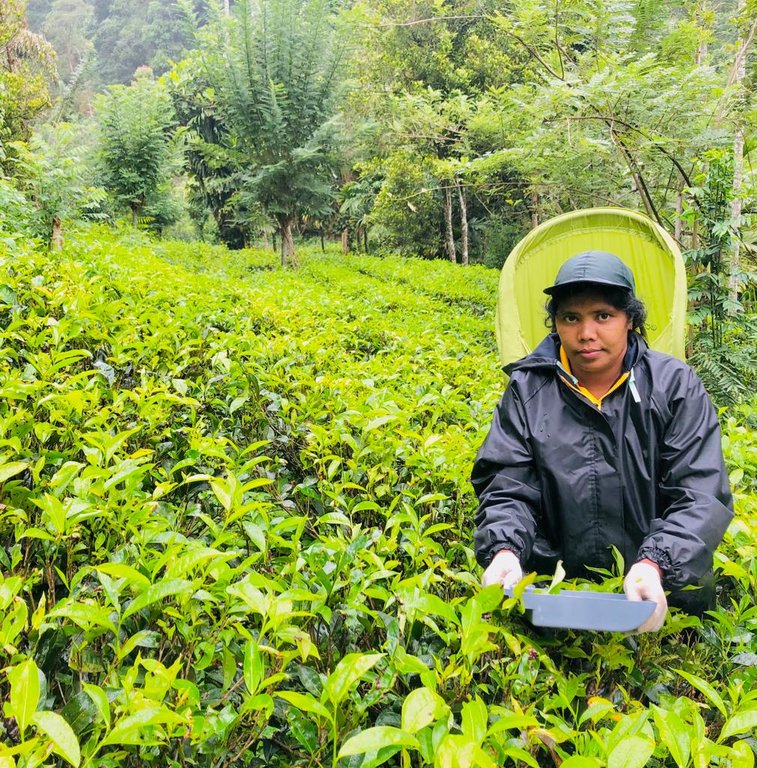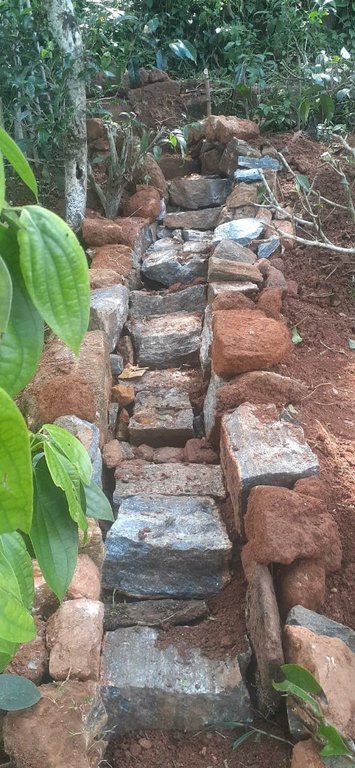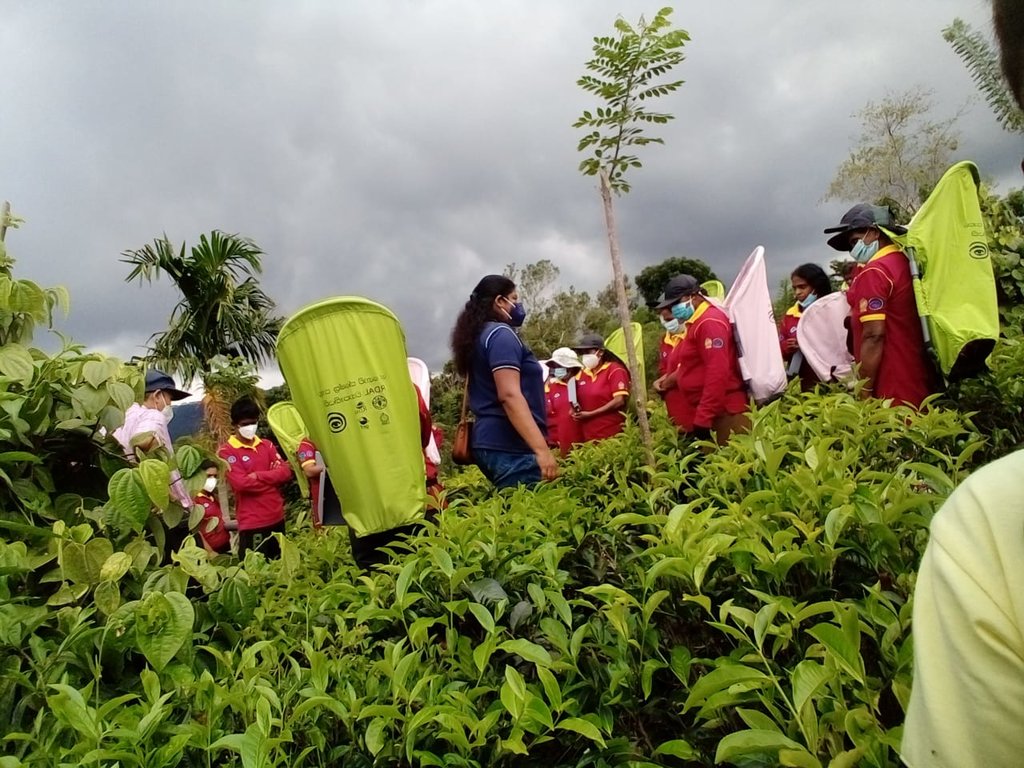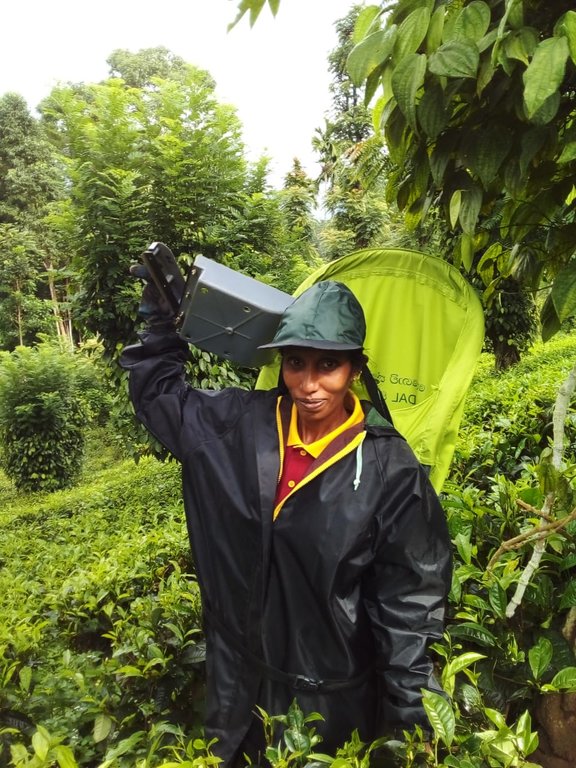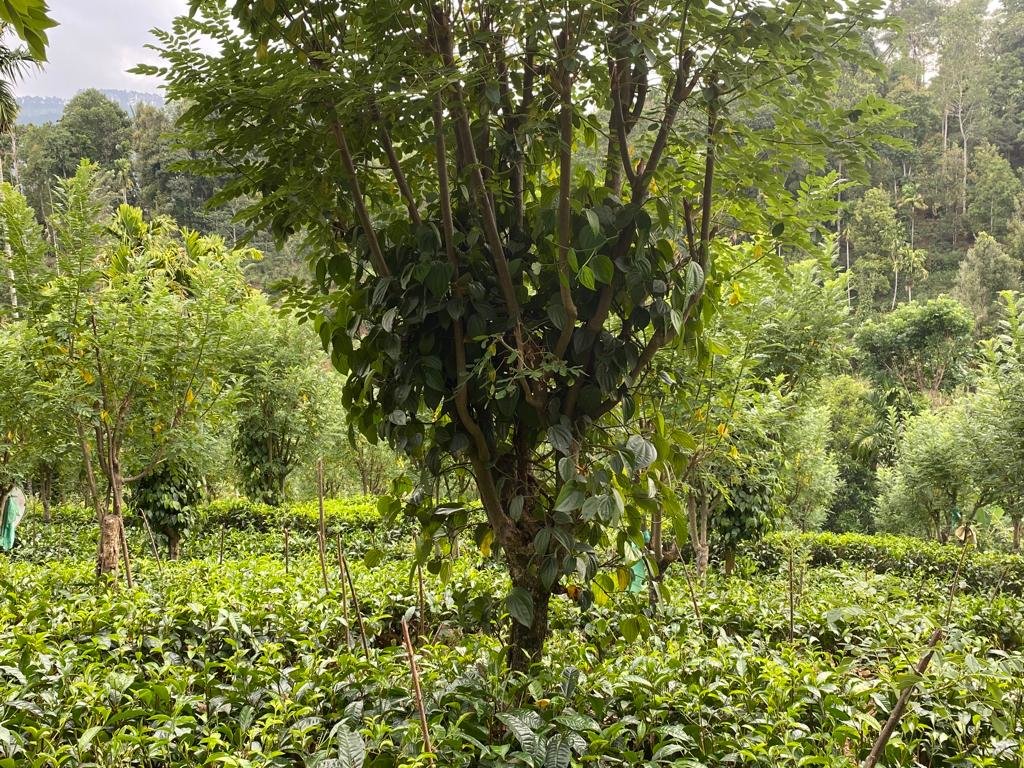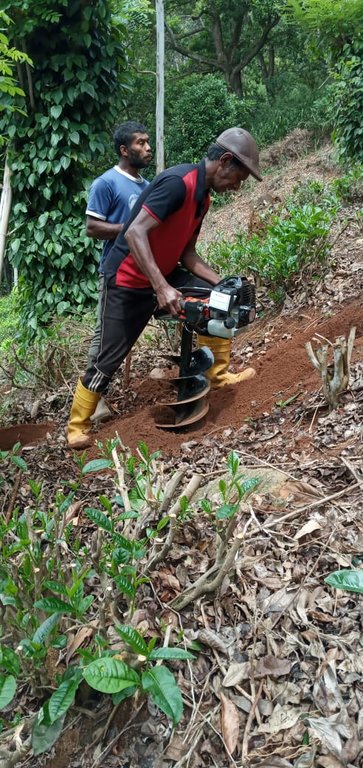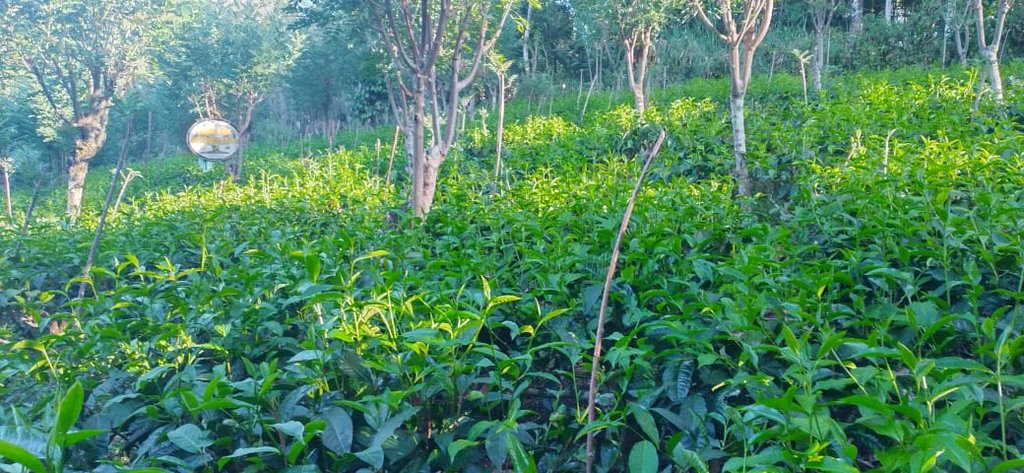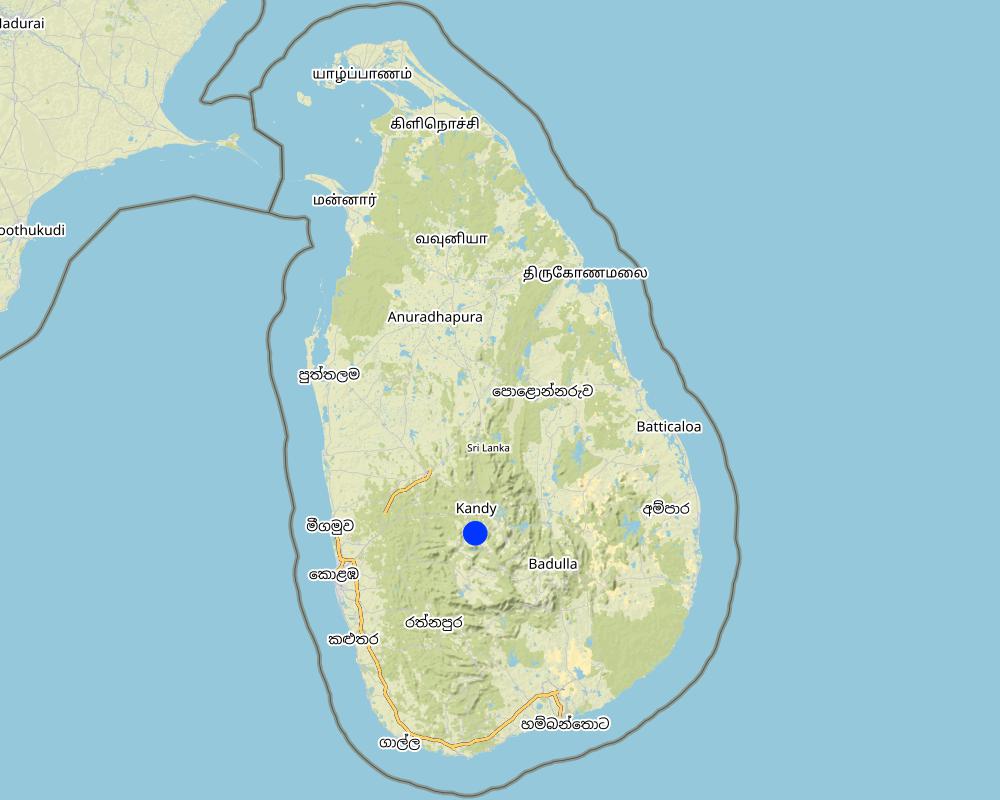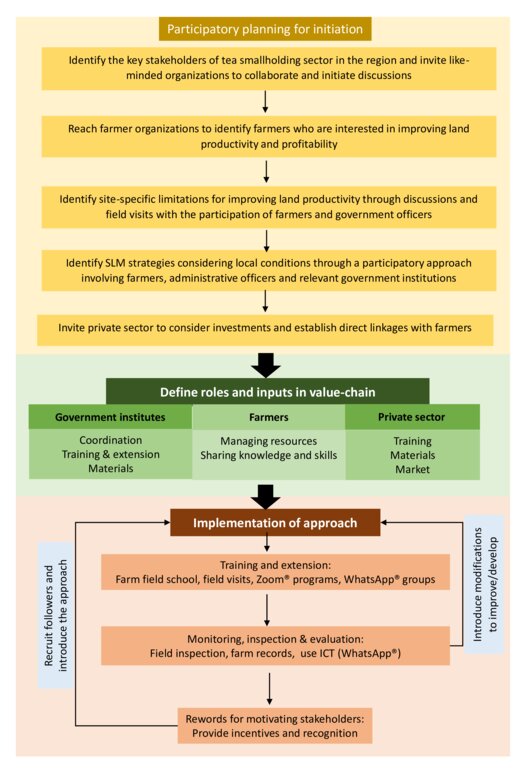Inter-sectoral collaboration for sustainable land management in tea smallholdings [Шри-Ланка]
- Создание:
- Обновить:
- Составитель: Head Soil Science
- Редактор: –
- Рецензенты: William Critchley, Rima Mekdaschi Studer
Inter-sectoral collaboration for sustainable land management in tea smallholdings
approaches_6182 - Шри-Ланка
Просмотреть разделы
Развернуть все Свернуть все1. Общая информация
1.2 Контактные данные специалистов и организаций, участвующих в описании и оценке Подхода
co-compiler:
co-compiler:
Agrarian Research and Production Assistant:
Iroshini Senevirathna
+94778278582
iroshinisenavirathna@gmail.com
Department of Agrarian Development
Agrarian Research and Production Assistant Office, "Nila Sewana", Pambadeniya
Шри-Ланка
землепользователь:
Pushpa Ranjani
+94767817221
“Sithamu Ranliya” farmer's organization
Pambadeniya, Panvilathanna
Шри-Ланка
Название проекта, содействовавшего документированию/оценке Подхода (если применимо)
Rehabilitation of Degraded Agricultural Lands in Kandy, Badulla and Nuwara Eliya Districts in the Central Highlands of Sri LankaНазвание организации (-ий), содействовавших документированию/оценке Подхода (если применимо)
Faculty of Agriculture, University of Peradeniya, Sri Lanka (AGRI.PDN) - Шри-Ланка1.3 Условия, регламентирующие использование собранных ВОКАТ данных
Когда были собраны данные (на местах)?
25/02/2022
Составитель и ответственный/-ые специалист(-ы) согласны с условиями, регламентирующими использование собранных ВОКАТ данных:
Да
2. Описание Подхода УЗП
2.1 Краткое описание Подхода
Participatory land restoration with the collective efforts of different stakeholders can assure sustainable use of land-resources. This approach promoted sustainable land management technologies such as agroforestry, soil conservation, and soil fertility enhancement practices through inter-sectoral collaboration, including the use of digital tools and Farmer Field Schools (FFS) to provide training and resources, disseminate knowledge, improve market-orientation of farmers, and monitor and evaluate the progress of activities for rehabilitating and increasing the productivity of degraded tea smallholdings in the Central Highlands of Sri Lanka.
2.2 Подробное описание Подхода
Подробное описание Подхода:
Due to unsustainable land management practices the monthly average green-leaf yield of tea smallholdings in Maligamale watershed in the Central Highlands of Sri Lanka is as low as 1000 kg/hectare, whereas the potential is 2400 kg/hectare. Soil erosion, soil fertility decline, low plant density, and poor shade management are among the main reasons for low productivity. This causes reduced household incomes and farmers’ ability to invest in sustainable land management (SLM) practices. Inefficiencies in top-down extension methodology, lack of awareness and training on tea cultivation techniques, poor business practices, lack of access to services and poor perceptions about SLM have reduced profit margins of tea smallholdings. Hence, the aim/ objectives of the approach are to increase the land productivity in tea smallholdings and increase farmer’s incomes and gain environmental benefits through proper implementation of SLM practices. To address this, the Rehabilitation of Degraded Agricultural Land Project (RDALP) introduced a participatory approach together with Tea Smallholdings Development Authority (TSHDA), Department of Agrarian Development and other relevant government institutions, the private sector and farming community. The approach considered methods for strengthening linkages between stakeholder groups, providing training and resources for SLM practices, enhancing market orientation, using ICT for knowledge sharing, monitoring and evaluation, improving perceptions of farming community on agriculture and enhancing food-security of the households.
Firstly, tea smallholders who volunteered to learn about SLM were linked with the experts to collectively develop a participatory land restoration proposal. Site specific limitations for productivity improvement, recommendations, roles of different stakeholders, and training and material needs were identified in the proposal. The existing institutional setup was used for coordination of activities. The experts from government institutes provided training on SLM through farmer field schools, field demonstrations and ICT tools. More specifically, farmers were educated on soil conservation and soil fertility management practices: these included producing organic fertilizers using locally available resources, building live fences with green-manure crops and edible crops, intercropping using export agriculture crops, in-filling, selective weeding, developing and maintaining nurseries, using machinery for cutting pits and harvesting, using safety measures during field operations, and shade tree management. In addition, farmers have been encouraged to share good-practices, keep records and practice soil test-based decision making for nutrient management. Farmers and officers effectively used WhatsApp®, Zoom® and Facebook® for knowledge sharing and for monitoring and evaluating progress. Dissemination of knowledge using ICT and performance-based rewarding helped to recruit more farmers as followers. The TSHDA supported with extension service and regular monitoring of progress. With the support of government institutes, farmers were linked with private sector companies to promote market orientation. Export agriculture crops such as peppers, vanilla, areca nut and cloves were successfully incorporated into tea smallholding landscape, allowing farmers to earn an extra income. The partners from the private sector provided planting materials and extension services to transfer necessary knowledge and skills to the farmers. Machinery was provided to farmer organizations for the members to share.
Improving profitability of farming, improving hygiene and safety of farmers, and reducing time spent on agronomic practices have uplifted the living-status of famers and increased their willingness to invest in SLM. These characters could attract youth to the sector.
2.3 Фотографии, иллюстрирующие Подход
2.4 Видеоматериалы по применению Подхода
Комментарий, краткое описание:
https://www.youtube.com/watch?v=SU3--fHKY1k
Application of ICT for knowledge dissemination and agricultural extension service
Дата:
20/07/2021
Место:
Pambadeniya, Panvilathanna
2.5 Страна/ регион/ место, где применялся Подход
Страна:
Шри-Ланка
Административная единица (Район/Область):
Kandy District- Central Province
Более точная привязка места:
Pambadeniya village
Комментарии:
The region is in the Maligamale watershed in the Central Highlands of Sri Lanka.
Map
×2.6 Даты начала и окончания реализации Подхода
Год начала реализации:
2017
Комментарии:
Approach is still carrying out by land user
2.7 Тип Подхода
- в рамках проекта/ программы
2.8 Каковы цели/ задачи Подхода
The aims/ objectives of the approach are to increase the land productivity in tea smallholdings and increase farmers' income and environmental benefits through proper implementation of SLM practices.
2.9 Условия содействующие применению Технологии/ Технологий в рамках Подхода или затрудняющие его
Социальные/ культурные/ религиозные нормы и ценности
- содействуют
Increased livelihood requirements and access to education, market and health services
- затрудняют
Migration of youth and males to cities
Наличие/ доступность финансовых ресурсов и услуг
- содействуют
Providing funds/ subsidies has increased the access to financial resources (subsidy schemes of TSHDA, Loan facilities of tea factories)
- затрудняют
Access of farmers to resources is limited by their financial situation as well as geographic location.
Институциональные условия
- содействуют
An institutional set-up for facilitating the approach already exists and all technical support is providing by institutes
- затрудняют
Mandate of some institutions are not clearly defined. Decision making is very often a top-down approach
Сотрудничество/ координация действий
- содействуют
Institutes have some level of collaboration
- затрудняют
There is lack of motivation to initiate collaboration and the level of collaboration depends on the commitments of the officers. Institutional mechanisms do not encourage the collaborations
Нормативно-правовая база (землевладение, права на земле- и водопользование)
- содействуют
Some land users own their land
- затрудняют
Some lands used by farmers are owned by the state and there are issues on land rights. Water availability is problematic to farmers as the crop is maintained as a rainfed crop. In the region, drinking water is supplied in ten days interval during dry-months
Программные документы/ руководящие установки
- содействуют
National soil conservation act
- затрудняют
Implementation of policies to action is very low
Управление земельными ресурсами (принятие решений, осуществление и контроль за выполнением)
- содействуют
Farmers participated in the decision-making process related to land management. Land is maintained based on the advice given under the approach. Most of the technologies introduced were not gender biased and therefore, involvement of women in management practices increased
- затрудняют
Dependence on males is high for agronomic practices in tea-cultivation
Осведомленность в области УЗП, доступность технической поддержки
- содействуют
Farmers were guided through farmer training programs, practical sessions, farmer field schools, Zoom® meetings, sharing knowledge through WhatsApp® groups and Facebook.
- затрудняют
Shortage of tea extension officers
Рынки (для приобретения материалов и услуг, продажи продукции) и цены
- содействуют
Private companies come to fields to purchase products and they provide extension support and material inputs to some extent to the farmers who have established links with them
- затрудняют
Market orientation of farmers is low and their ability to negotiate prices is poor due to various factors
Объем работ, доступность рабочей силы
- содействуют
Labour resources are available. Introduction of machinery created shared responsibilities and reduced labour demand while creating an income source for the farmer organizations. Decent working environment with safety kits and machineries will encourage the labour force to remain in the sector
- затрудняют
Labour force continuously moving away from the industry
3. Участие и распределение ролей заинтересованных сторон
3.1 Заинтересованные стороны, участвующие в реализации Подхода и их роли
- местные землепользователи/ местные сообщества
Men and women farmers are involved in tea cultivation
They involved in practicing SLM technologies as the technologies were not gender biased. But the operation of mechanical weeder and auger for infilling are mainly done by male farmers.
- организации местных сообществ
Farmer organizations
Support coordination of activities with farmers
Support Farmer Field Schools
Maintain common equipment and rent for members and non-members to support SLM practices
- эксперты по УЗП/ сельскому хозяйству
Tea Smallholding Development Authority, Department of Agrarian Development, Department of Export Agriculture, Department of Agriculture
Provide tea plants for infilling, promote inter-cropping and provide technical guidance to farmers
Serve as resource-persons in Farmer Field Schools and in WhatsApp® groups
- ученые-исследователи
University of Uva Wellassa, Sri Lanka
Study the effectiveness of knowledge dissemination approach and effectiveness of some SLM technologies
- частный сектор
Several private sector companies are involved (Bio Food (Pvt) Ltd, Adamjee Lukmanjee (Pvt) Ltd)
Buying products, providing planting materials and continuing extension services to transfer necessary knowledge and skills to the farmers who are linked with them
- местные власти
Local government institutes are involved in the process (Tea Smallholdings Development Authority (TSHDA), Department of Agrarian Development, Department of Agriculture, Department of Export Agriculture, Divisional Secretariat office- Doluwa
Capacity building, advisory services on fertilizer usage, land management, crop selection etc.
- государственные власти (отвечающие за планирование или принятие решений)
Ministry of Environment
Helps to raise awareness among private and government sector stakeholders and within communities about SLM approaches and technologies,
Project coordination and partial financial support
- международные организации
Food and Agriculture Organization of the United Nations
Project coordination, partial financial support and capacity building
Если участвовало несколько заинтересованных сторон, назовите ведущую организацию:
Tea Smallholdings Development Authority (TSHDA)
3.2 Участие местных землепользователей/ местных сообществ на разных стадиях реализации Подхода
| Участие местных землепользователей/ местных сообществ | Перечислите участников и опишите их вовлеченность | |
|---|---|---|
| инициирование/ мотивация | интерактивное | Government agencies, representatives from farmer organizations, RDALP team. Discussions to develop participatory land use plans for a region and identify the sectors to be developed |
| планирование | интерактивное | Government agencies, representatives from farmer organizations, RDALP team Discussions, site visits and field programs to identify factors limiting land productivity and implementation of SLM practices Identify strategies to address these limitations Identify how the private sector can contribute and invite them to invest |
| выполнение | интерактивное | Government agencies, leaders of farmer organizations, farmers, RDALP team, private sector companies Training and dissemination of knowledge through demonstrations, farmer training programs, farmer field schools Progress monitoring and evaluation Provide advisory services to farmers as needed Conduct performance-based rewarding to motivate the practitioners and to recruit followers |
| мониторинг/ оценка | интерактивное | TSHDA, RDALP team, farmers, private sector companies make observations in fields, guiding land users, exchange photos through whatsapp® Some private sector companies also involve in monitoring and field evaluating process (Adamjee Lukmanjee (Pvt) Ltd) |
3.3 Схема реализации (если имеется)
Описание:
Before implementing the approach the level of productivity of tea lands that belong to the farmers who participated in the project were in class ‘C’ and below. In this scale of productivity lands were classified from A to D where A is the best and D is the worst. After implementation of the approach most of the fields upgraded to ‘A’ and ‘B’ performance levels. An interview conducted with a farmer revealed that the average green-leaf tea yield before and after participating in the approach were 1000 kg/ha/month and 2400 kg/ha/month, respectively.
Автор:
Warshi S. Dandeniya
3.4 Принятие решений по выбору Технологии/ Технологий УЗП
Укажите, кто принимал решение по выбору применяемой Технологии/ Технологий:
- все участники как часть процесса совместных действий
Поясните на чём было основано принятие решений:
- анализ подробно описанного опыта и знаний по УЗП (принятие решений на основе подтвержденных фактов)
- результаты исследований
- личный опыт и мнения (незадокументированные)
4. Техническая поддержка, повышение компетенций и управление знаниями
4.1 Повышение компетенций/ обучение
Проводилось ли обучение землепользователей/ других заинтересованных лиц?
Да
Укажите, кто проходил обучение:
- землепользователи
- местный персонал/консультанты
Если существенно, укажите гендерный и возрастной состав, статус, этническую принадлежность и т.д.
Training was provided for both men and women; age between 20-70 years old
Тип обучения:
- обмен опытом между фермерами
- опытные участки
- общие собрания
- курсы
Тип обучения:
- Zoom discussions, Farm Field Schools
Рассматриваемые темы:
Soil conservation practices, intercropping in tea lands, organic fertilizer preparation (compost tea, vermi- compost), burying of pruned plant parts, infilling, documentation, improving tea buds quality and quantity, handling of machines for cutting pits and tea plucking
Комментарии:
Farmer trainings are much important to spread easy agronomic practices and scientific knowledge to farmers
4.2 Консультационные услуги
Есть ли у землепользователей возможность получать консультации?
Да
Укажите, где именно оказываются консультационные услуги:
- на полях землепользователей
Описание/ комментарий:
Demonstration, advisory service was carried out through: government extension system, agricultural instructors and some private sector companies such as Adamjee Lukmanjee (Pvt) Ltd company which is giving support to enhance vanilla cultivation as an intercrop
4.3 Институциональная (организационная) поддержка
В ходе реализации Подхода были ли организованы новые институциональные структуры или поддержаны уже существующие?
- да, умеренно
Укажите уровень, на котором структуры были укреплены или вновь созданы:
- местные
Укажите тип поддержки:
- повышение компетенций/ обучение
- оборудование
- providing safety kits and tea plants for infilling
Подробнее:
Organizing and conducting training programs, providing machineries for tea plucking and cutting pits, distribute safety kits among land users
4.4 Мониторинг и оценка
Являются ли мониторинг и оценка частью Подхода?
Да
Если да, будет ли данный документ использоваться для мониторинга и оценки?
Нет
4.5 Научные исследования
Были ли научные исследования частью Подхода?
Да
Укажите темы исследований:
- технология
5. Финансирование и внешняя материальная поддержка
5.1 Годовой бюджет мероприятий по УЗП в рамках Подхода
Если точный годовой бюжет неизвестен, укажите примерный диапазон затрат:
- 100 000-1 000 000
5.2 Финансирование и внешняя материальная поддержка, предоставляемая землепользователям
Предоставлялась ли землепользователям финансовая/ материальная поддержка для применения Технологии /Технологий?
Да
Если да, укажите тип(-ы) поддержки, кто ее предоставил и условия предоставления:
Provide machinery for cutting pits and plucking, safety kits and tea plants for infilling as material support, provide financial support for soil testing, to add liming material for correcting soil pH for those who performed soil testing
The material and financial support was provided by RDALP team with contributions from TSHDA and private sector based on performance evaluation
5.3 Субсидии на отдельные затраты (включая оплату труда)
- оборудование
| Укажите, какие ресурсы были субсидированы | В какой степени | Опишите субсидии подробнее |
|---|---|---|
| техника | профинансированы полностью | Tea plucking machines, grass cutting machines and machine for cutting pits in tea lands |
| инвентарь/ инструменты | профинансированы полностью | Tea buds collecting buckets |
- сельскохозяйственные
| Укажите, какие ресурсы были субсидированы | В какой степени | Опишите субсидии подробнее |
|---|---|---|
| Planting materials, liming materials | профинансированы полностью | Tea plants for infilling, liming materials to correct soil pH, soil testing service |
- другие
| Другой (какой именно) | В какой степени | Опишите субсидии подробнее |
|---|---|---|
| Safety kits | профинансированы полностью |
Если труд землепользователя был существенным вкладом, укажите, был ли этот вклад:
- добровольный
Комментарии:
Most of the time family members are engaged with field activities and hire labour for tea plucking
5.4 Кредитование
Предоставлялись ли в рамках Подхода кредиты на мероприятия УЗП?
Нет
5.5 Другие методы или инструменты стимулирования
Использовались ли другие методы или инструменты стимулирования для продвижения Технологий УЗП?
Да
6. Анализ влияния и заключительные положения
6.1 Влияние Подхода
Сумел ли Подход расширить возможности местных землепользователей, повысить участие заинтересованных сторон?
- Нет
- Да, немного
- Да, умеренно
- Да, существенно
Application of organic fertilizers such as compost tea, vermi-compost enhance the market value and some farmers ventured into organic tea production
Сумел ли Подход дать возможность принимать решения на основе подтвержденных фактов?
- Нет
- Да, немного
- Да, умеренно
- Да, существенно
Participatory approach in all stages of the project and farmer field schools encouraged the farmers and officers for evidence-based decision making. This also helped to recruit followers for the approach.
Сумел ли Подход помочь землепользователям внедрить и поддерживать технологии УЗП?
- Нет
- Да, немного
- Да, умеренно
- Да, существенно
Approach helps to maintain better environment within the community as it introduced practices that improved safety and hygiene of the farmers while being more efficient. Farmers have been maintaining the SLM technologies
Сумел ли Подход улучшить согласованность действий и повысить рентабельность применения практик УЗП:
- Нет
- Да, немного
- Да, умеренно
- Да, существенно
Approach used existing institutional set-up and farmer organizations to coordinate the activities. Therefore, it was cost effective and helped to strengthen the collaborations between stakeholders
Сумел ли Подход мобилизовать/ расширить доступ к финансовым ресурсам для применения практик УЗП?
- Нет
- Да, немного
- Да, умеренно
- Да, существенно
Introducing private sector collaborations and improving market orientation of farmers helped to attract financial support to maintain sustainability of the approach
Сумел ли Подход расширить знания и возможности землепользователей в применении практик УЗП?
- Нет
- Да, немного
- Да, умеренно
- Да, существенно
Approach improved the knowledge and capacity of practitioners. Although only about 25 farmers attended farmer field school the number of farmers who joined WhatsApp group is high as 70. Farmers are sharing knowledge and experiences and were able to improve land productivity through the approach
Сумел ли Подход расширить знания и возможности других заинтересованных сторон?
- Нет
- Да, немного
- Да, умеренно
- Да, существенно
The knowledge and capacities of other stakeholders were improved similarly. Several officers were trained on SLM practices and technologies, use of ICT for extension, etc
Сумел ли Подход укрепить сотрудничество между заинтересоваными сторонами/ выстроить механизмы сотрудничества?
- Нет
- Да, немного
- Да, умеренно
- Да, существенно
Approach helps to strengthen the collaboration between institutes and stakeholders
Сумел ли Подход снизить остроту конфликтов?
- Нет
- Да, немного
- Да, умеренно
- Да, существенно
Improving communication through the project supported the stakeholders to build healthy relationships.
Сумел ли Подход расширить возможности социально и экономически уязвимых групп?
- Нет
- Да, немного
- Да, умеренно
- Да, существенно
Approach helps to earn income in different ways. It is not limited for tea. They can earn money by selling the harvest from intercropping such as vanilla, pepper cultivation, managing nurseries, etc.
Сумел ли Подход содействать гендерному равенству и расширить права и возможности женщин и девочек?
- Нет
- Да, немного
- Да, умеренно
- Да, существенно
Women engagement is high as the new agronomic measures help to reduce time spent on field practices
Сумел ли Подход стимулировать молодежь/ будущее поколение землепользователей заниматься УЗП?
- Нет
- Да, немного
- Да, умеренно
- Да, существенно
Usage of ICT knowledge, improving hygiene and safety of farmers, increased their willingness to invest on SLM and these characters could attract youth to the sector
Сумел ли Подход способствовать улучшению продовольственой безопасности/ качества питания?
- Нет
- Да, немного
- Да, умеренно
- Да, существенно
Increased family improved food security of the practitioners. In addition, the approach promoted intercropping tea with export agricultural crops/ fruit crops and the use of edible crops in fencing. These also increased food supply. Since the mechanization and safety kits helped to reduce time spent on field work the farmers, especially women, were able to invest more time in their home garden and increase the provision of nutritious food to the household
Сумел ли Подход расширить доступ к рынкам?
- Нет
- Да, немного
- Да, умеренно
- Да, существенно
Linkages developed through government entities increased market access. Further some farmers ventured into organic tea production using SLM practices and training provided through the approach. This helped them to reach a niche market
Сумел ли Подход улучшить способность землепользователей адаптироваться к изменениям климата и смягчать последствия катастрофических погодных явлений?
- Нет
- Да, немного
- Да, умеренно
- Да, существенно
Improving soil fertility status has improved the resilience of tea stand for drought. Therefore, the effect of climate change on the income was only slightly affected. Further the SLM techniques they practiced helped them to rely less on inorganic fertilizers and therefore, the farmers were less affected by the fertilizer shortage in the market that happened due to changes in government policies. Using ICT tools for communication helped the farmers to share knowledge and coordinate activities even under COVID19 pandemic situation. They have got used to distant learning methods with this and now able to seek support from experts without having to travel
Сумел ли Подход привести к созданию новых рабочих мест/ к расширению возможностей получения дохода?
- Нет
- Да, немного
- Да, умеренно
- Да, существенно
Farmer organizations were given some machinery for weeding and land preparation like activities. The members from the farmer organizations, who were trained to use the machinery, provided their service to the farmers for a payment from which a fraction is given to the farmer organization for maintaining the equipment. In addition, some farmers started nursery management as a business
6.2 Основные причины, побуждающие землепользователей внедрять УЗП
- рост продуктивности
Infilling and improving soil fertility increased canopy cover leading to increased productivity
- рост прибыли (доходности) и рентабельности
Product variability inside field supported diversity of income sources. Farmers who practiced organic farming methods were able to reach a niche market and get ore income
- снижение деградации земель
Due to well organized farmer training sessions or demonstrations in their fields SLM practices became more popular and farmers invested to maintain the practices they initiated
- снижение риска катастрофических погодных явлений
Fields established well with SLM technologies were more resilient to drought and fertilizer shortage in the market
- престиж, общественное давление/ солидарность
Improvement in health and hygiene of workers improved their image. Operating WhatsApp® groups also improved social cohesion
- приобретение знаний и опыта в области УЗП
Due to regular observations of agricultural officers
- улучшение эстетической привлекательности
With live fences and good canopy cover of the tea stand the field looks healthy and farmers claimed they were motivated to continue the good practices because of these
6.3 Долгосрочная устойчивость мероприятий в рамках Подхода
Могут ли землепользователи самостоятельно (без внешней поддержки) продолжать применение того, что было реализовано в рамках Подхода?
- да
Если да, опишите как:
Approach has converted the most of non- productive lands to productive levels with the support of external bodies. Lands needs low external inputs as farmers produce required fertilizers by themselves in their own land by using natural organic materials. The crop diversification helps to reduce risk of crop losses and increase various income pathways to farmer. As well as approach helps access to markets. And there is a trend of farmers who succeed with approach to share their knowledge and experience with others. The ICT knowledge provided by the approach is much useful in that aspect. So, land users can sustain what has been implemented through the approach.
6.4 Сильные стороны/ преимущества Подхода
| Сильные стороны/ преимущества/ возможности по мнению землепользователей |
|---|
| Increased the production and product variability due to practicing intercropping |
| Reducing land degradation |
| Increased market opportunities |
| Improve the knowledge due to training programs and regular visits of agricultural officers |
| Сильные стороны/ преимущества/ возможности по мнению составителя или других ключевых специалистов |
|---|
|
Encouraging the participation of women in the field-based activities as a result of hygienic and time saving practices ex; mechanization, introduction of safety kits |
| Increase in soil fertility and reduction of soil erosion (due to application of organic manure, vermi-compost and improve the ground cover due to minimum tillage) |
| Using ICT in knowledge dissemination. This increased social cohesion, resilience and fast dissemination of knowledge. |
| Facilitating inter-sectoral collaboration taking a participatory approach throughout the process |
6.5 Слабые стороны/ недостатки Подхода и пути их преодоления
| Слабые стороны/ недостатки/ риски по мнению землепользователей | Возможные пути их преодоления/снижения? |
|---|---|
| Water scarcity | Better to introduce rain water harvesting system and improved irrigation methods like drip-irrigation to increase water use efficiency |
| Males are need to use some heavy machinery | Males are migrating to cities looking for jobs and therefore, the field activities are affected. Need to enhance income further to retain them |
| Слабые стороны/ недостатки/ риски по мнению составителя или ответственных специалистов | Возможные пути их преодоления/снижения? |
|---|---|
| A systematic impact assessment with key performance indicators should be developed with the involvement of farmers at the initial stage. This was missing in the approach and it was done only towards the latter part of the project | Farmers have not maintained records prior to inception of the project. It is important to develop key performance indicators at the very beginning to evaluate how the system performance change so that even farmers can witness the changes through time. Otherwise, they cannot recall the situation before implementing the approach |
7. Справочные материалы и ссылки
7.1 Методы сбора/источники информации
- выезды на места, полевые обследования
- опросы землепользователей
- опросы специалистов/экспертов по УЗП
- данные, собранные из отчетов и достоверных документов
7.2 Ссылки на опубликованные материалы
Название, автор, год публикации, ISBN:
Improving livelihoods of women tea smallholders through sustainable land management practices, 2021
Где опубликовано? Стоимость?
Daily Financial Times newspaper
7.3 Ссылки на материалы, доступные онлайн
Название/ описание:
Improving livelihoods of women tea smallholders through sustainable land management practices, 2021
Адрес в сети Интернет:
https://srilanka.un.org/en/127297-improving-livelihoods-women-tea-smallholders-through-sustainable-land-management-practices
Ссылки и модули
Развернуть все Свернуть всеСсылки
Нет ссылок
Модули
Нет модулей


